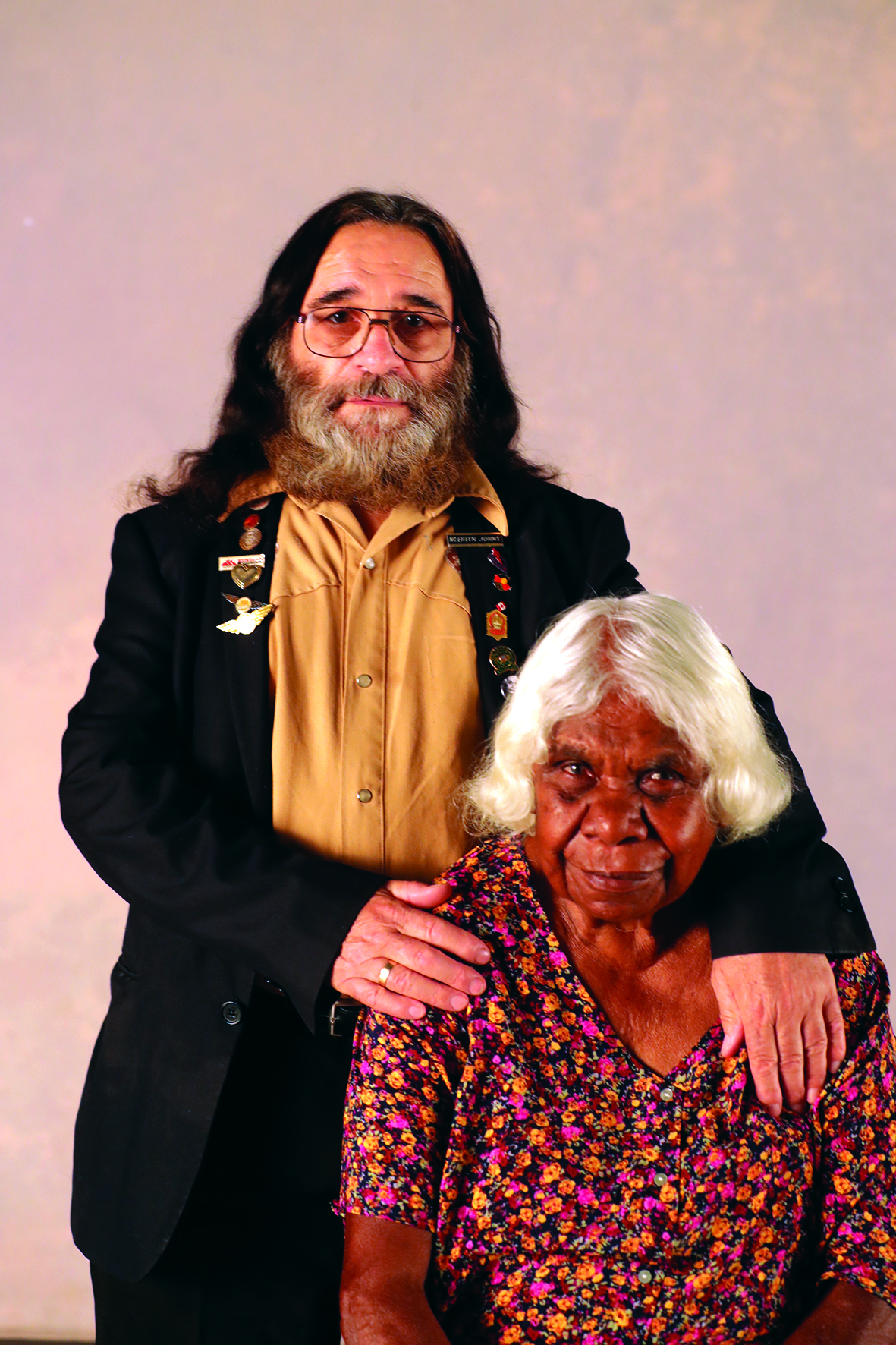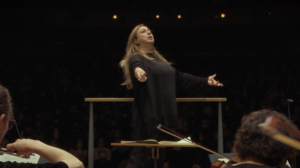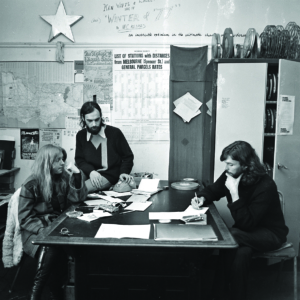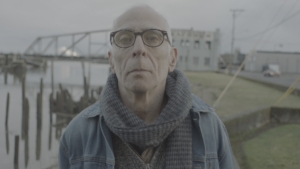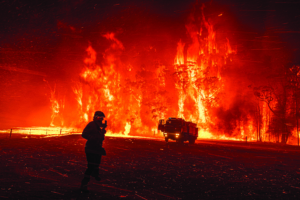Filmed over a ten-year period in Mparntwe (Alice Springs), Audrey Napanangka (Penelope McDonald, 2022) is a documentary that grew out of an even longer friendship: that shared by director McDonald and Warlpiri artist Audrey Napanangka Martin, who first met in the 1980s in Lajamanu, a remote community of around 600 people of the Warlpiri nation on the northern edge of the Tanami Desert.[1]See Matthew Eeles, ‘Interview: Penelope McDonald’, Cinema Australia, 18 August 2022, <https://cinemaaustralia.com.au/2022/08/18/interview-penelope-mcdonald/>, accessed 7 October 2022. As McDonald describes,
I had moved to the Northern Territory from Sydney to work in Aboriginal education [in a bilingual school, where Warlpiri was taught[2]ibid.]. It was there that I met Audrey. She operated the telephone system, and I rang out a lot to family and friends. She was bubbly and full of life, and if you went away from community, she always asked you to bring something back. We got to know each other and stayed in touch.
Around twenty-five years later, the two decided to make a film. Its director, having ‘walked alongside [Napanangka] for a long time as an ally’, wanted the world to see her resilience in the face of the lifelong challenges of institutional racism. The result is Audrey Napanangka, a nuanced, multifaceted documentary portrait. The camera follows its subject as she looks after numerous children, teaches about country, works on her art, delves into her past, meets with tragedy and pursues political change all the way to Canberra – all the while maintaining her sense of humour, optimism and courage in the face of the many and varied effects of colonisation.
Rather than approaching the documentary through the framework of a traditional filmmaker–subject relationship, McDonald says, she and Napanangka worked on the project together:
It was very much a collaboration. I’m the director, but Audrey was there every step of the way […] All the way through, it was very important to keep showing [the footage] to her […] She revealed to me, as filmmaker, and to you, as the audience, as much as she was happy to reveal. She was very comfortable with the camera and the crew, because she’d been in so many films before.
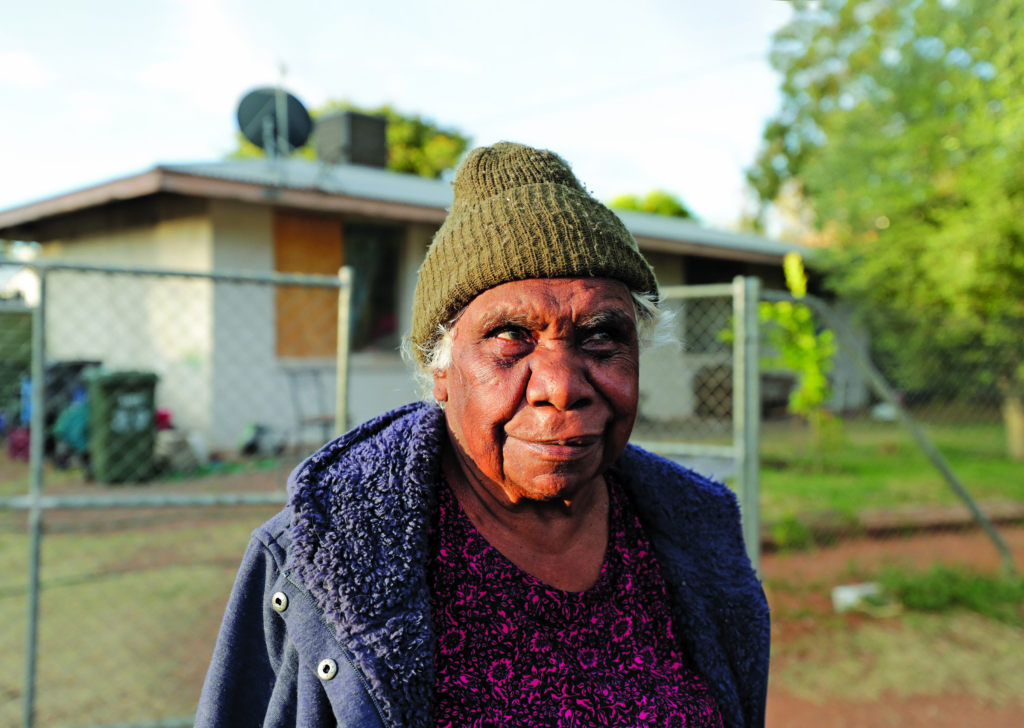
McDonald recruited Napanangka for her first on-screen role[3]This was for a short corporate commission. in 1992, convinced that she would be ‘brave’ enough to do it. She has since appeared in films such as Rabbit-Proof Fence (Phillip Noyce, 2002), Green Bush (Warwick Thornton, 2005), Samson & Delilah (Thornton, 2009) and Nulla Nulla (Dylan River, 2015), as well as TV series Kings in Grass Castles, Monsters We Met and Robbie Hood.[4]See Dov Kornits, ‘Audrey Napanangka: A Statement from the Heart’, FilmInk, 24 October 2022, <https://www.filmink.com.au/audrey-napanangka-a-statement-from-the-heart/>, accessed 3 November 2022.
The closeness of the duo’s friendship gives Audrey Napanangka an unusually intimate feel, one that is established from the beginning. Among the film’s opening scenes is a simple yet arresting shot in which Napanangka sits on the floor of a laundrette, watching a washing machine. The camera then cuts to her and her Sicilian husband, Santo Giardina, struggling to hang enormous blankets on a Hills hoist in their backyard and bickering lightheartedly about how it should be done.
While these details of domestic life at first appear mundane, they go to the film’s heart: Napanangka’s immense devotion to her family members, which is evident in her voiceover (spoken in Warlpiri): ‘My name is Audrey Napanangka. I’m always washing blankets. I look after a lot of people.’ As McDonald describes:
In my mind’s eye, the film was always focused on Audrey; […] and the big thing for her has been family and bringing up children with [Santo]. There was always that thread of children and family, and what that means […]
I know her family well – and they were familiar with me turning up with a camera. I carried a small one with me in my handbag a lot of the time so I could turn it on if I saw something interesting was happening […] I like the idea of just observing life as it unfolds, rather than curating it.

Indeed, the many children in Napanangka’s care are as central to the film as Napanangka herself – and so too are the ways in which the children experience the three different cultures to which they are exposed: Warlpiri, English and Sicilian. As the film was shot over the course of a decade, viewers get to watch the children’s growth. ‘The family went through a lot [in that time],’ McDonald says. ‘Children who were four years old in the beginning were teenagers by the end.’ They talk and joke through everyday activities like being woken up for school, helping themselves to ice cream upon returning home and sharing a meal at a local Italian restaurant. We also see them experience milestones, such as a smoking ceremony for a newborn baby – which, Napanangka says, ‘makes the baby strong’ – and the initiation of a teenager. And they are shown to struggle with hardship, including when a child undergoes medical treatment for a hearing difficulty, another visits her mother in jail and, most distressingly, children are removed from Napanangka’s care. Utterly unable to accept this, Napanangka fights for their return, both privately and as one of a group of Aboriginal grandmothers who travel to Parliament House to protest against the continued removal of Aboriginal children from their families. All of these scenes were selected – with the help of editors James Bradley, Jane St Vincent Welch and Karryn de Cinque – from more than 160 hours of footage.[5]See Sean Slatter, ‘40-year Friendship at the Heart of Penelope McDonald’s Audrey Napanangka’, IF.com.au, 11 August 2022, <https://if.com.au/40-year-friendship-at-the-heart-of-penelope-mcdonalds-audrey-napanangka/>, accessed 7 October 2022.
Also vital to communicating the world of the documentary’s central figure are art and music. Napanangka was raised in a family of artists – her parents were painters, as is her younger sister and artistic mentor, Netta Williams Napanangka – and has been working in her field since the mid 1980s.[6]See Sabine Haider, ‘Biography’, Audrey Martin Napanangka artist page, Central Art website, <https://www.aboriginalartstore.com.au/artists/audrey-martin-napanangka/>, accessed 7 October 2022.6 The viewer is privy to her creative process as she sings and paints Dreaming stories, explaining along the way that her work depicts her father’s country. As McDonald conveys, this love of music is one that is shared by Napanangka and her husband:
Audrey and Santo are both very musical. Audrey is always painting and singing; she sings her Dreaming songs quite often. Santo plays piano accordion and carries a harmonica in his pocket, which he pulls out and plays. So we wanted to put some of that in, making sure it was true to who they are.
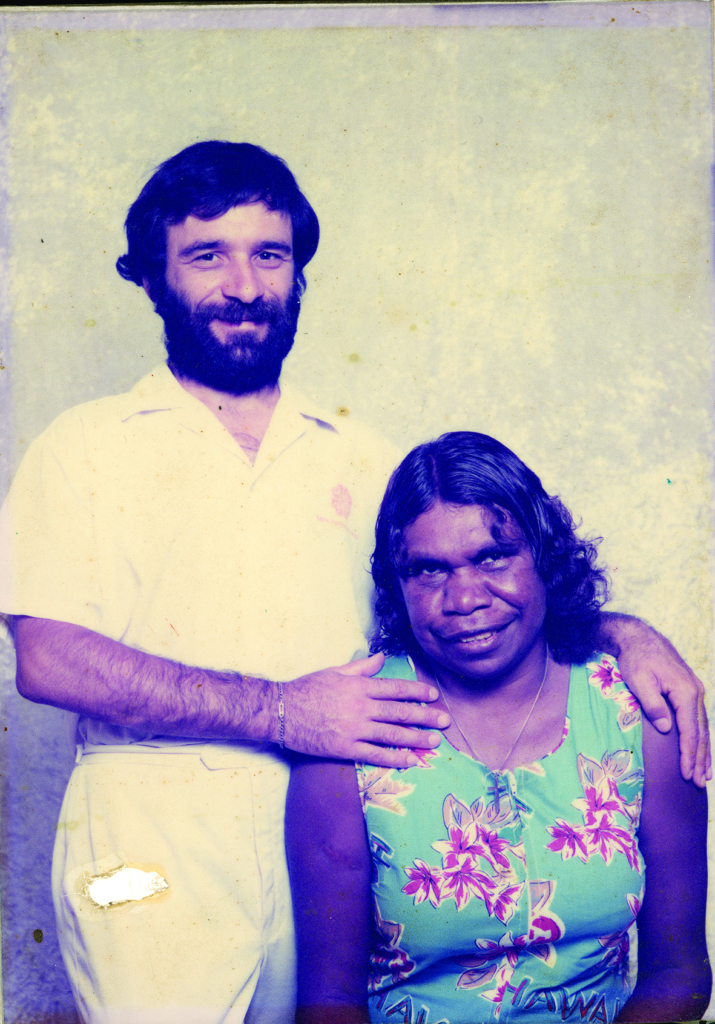
This diegetic music interweaves with the soundtrack, on which McDonald collaborated with composer David Bridie. Their goal was to amplify the film’s setting, rather than to produce a particular emotional effect on the viewer, McDonald explains:
I avoided lyrics because I wanted the film to speak for itself and the audience to respond to it freely – not to be told too much how to respond […] I was fortunate to work with [Bridie], who composed all the music. He would send me samples, then we’d talk about them and refine them.
Despite the familiarity shared by McDonald, Napanangka and the latter’s family members, the process of making the film was not without its surprises. As their collaboration deepened over the years, McDonald came to learn more about Napanangka’s past, not least that she had had biological children who were among the stolen generations. As the director recounts,
I didn’t know she’d had babies […] and that they’d been taken from her and that she didn’t know much about what had happened to them […] We got the hospital records and that was even more disconcerting […] I was horrified. I’m still shocked and upset to this day […] But the thing about Audrey is that she picked herself up and has given her love to so many.
The revelatory nature of the filmmaking journey is reflected in the structure of the film. Rather than adopting an expository or chronological approach, McDonald positions the viewer as though they were a friend of Napanangka’s, gradually learning more about her at every meeting:
I think of the structure as an onion […] We spent a long time editing and trying different things and kept coming back to that original structure, and I believe it works. As layers are peeled back, more interesting things are revealed, and [the viewer] gradually gets to know Audrey […]
‘I think of the structure as an onion … As layers are peeled back, more interesting things are revealed, and [the viewer] gradually gets to know Audrey.’
– Penelope McDonald
It’s how friendships work, isn’t it, really? You get to know someone on the surface, and you don’t know the beginning of their life; and, as you make more time for one another, you get into more depth. There were things I didn’t know about Audrey which I found out during filming.
To intensify the effect of these revelations, McDonald explains, she chose to intersperse the observational footage with strikingly realistic re-enactments, shot on super 8:
I had the idea I wanted to show some of Audrey’s past. But you can’t just talk. You need images to go with the words […] Getting re-enactments right is always a challenge. We didn’t have a lot of crew and had to shoot them in a ridiculously short space of time […] but things fell into place when they needed to […] One of Audrey’s many nieces turned up at my house one day with a teenager. I thought, ‘You look exactly like Audrey.’ It turned out she was Audrey’s granddaughter – so she played Audrey as a young woman.
Super 8 goes back to my first experiences in film as a young person […] It’s so different [from] video […] You can hear it going around, and you know you only have a couple of opportunities per roll. You have to be really sparing; but, at the same time, as a one-woman band, you know you should just go for it […] It’s with bated breath that you send it off for processing, not knowing if it’s going to work or not. There’s an excitement and drama to it.
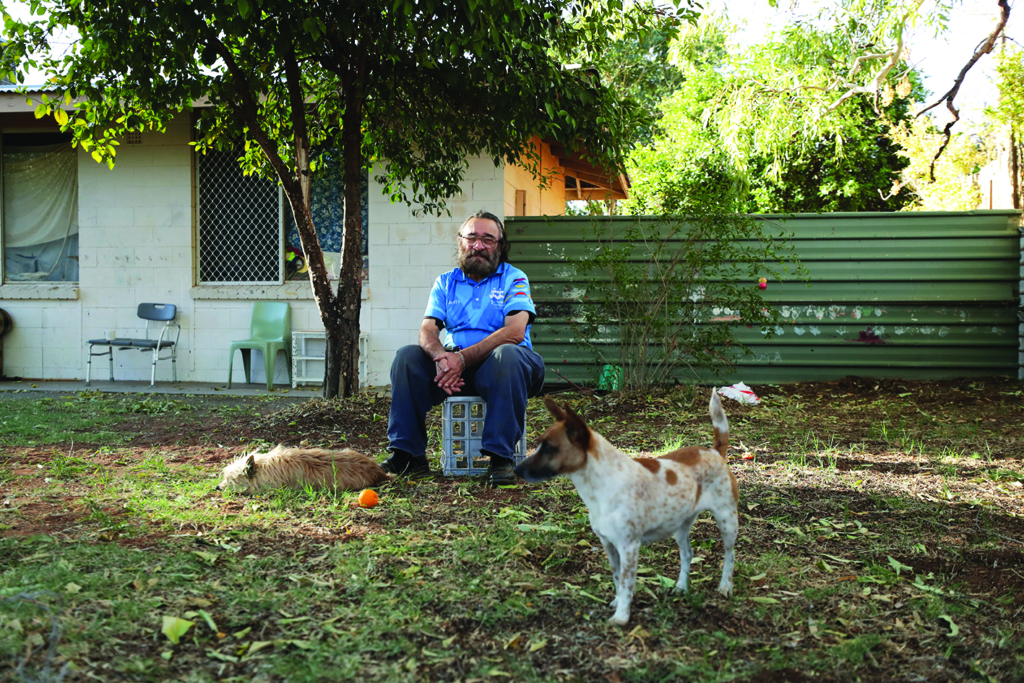
Another device crucial to immersing the viewer in Napanangka’s world is the inclusion of archival footage, some of which has recently been restored by the National Film and Sound Archive for the first time and has not been used in any other film. This includes material shot in the 1950s of Baptist missionaries teaching schoolchildren to read in Yuendumu, the community located 290 kilometres north-west of Alice Springs where Napanangka was born. Further, the viewer sees Napanangka’s private photos – including shots of her and Giardina as young lovers – footage of them visiting her parents-in-law in their home in Sicily and home videos of their children’s birthday parties.
This variety of sources creates an intensely personal, complex and nuanced picture of the many influences on Napanangka’s past and present. Ultimately, McDonald hopes that the film will
provide a window into a world people might not have seen before, and create greater understanding and empathy – and, therefore, change – in Australian attitudes and society. I know they sound like lofty aims, but I didn’t make the film [to not] be seen.
Endnotes
| 1 | See Matthew Eeles, ‘Interview: Penelope McDonald’, Cinema Australia, 18 August 2022, <https://cinemaaustralia.com.au/2022/08/18/interview-penelope-mcdonald/>, accessed 7 October 2022. |
|---|---|
| 2 | ibid. |
| 3 | This was for a short corporate commission. |
| 4 | See Dov Kornits, ‘Audrey Napanangka: A Statement from the Heart’, FilmInk, 24 October 2022, <https://www.filmink.com.au/audrey-napanangka-a-statement-from-the-heart/>, accessed 3 November 2022. |
| 5 | See Sean Slatter, ‘40-year Friendship at the Heart of Penelope McDonald’s Audrey Napanangka’, IF.com.au, 11 August 2022, <https://if.com.au/40-year-friendship-at-the-heart-of-penelope-mcdonalds-audrey-napanangka/>, accessed 7 October 2022. |
| 6 | See Sabine Haider, ‘Biography’, Audrey Martin Napanangka artist page, Central Art website, <https://www.aboriginalartstore.com.au/artists/audrey-martin-napanangka/>, accessed 7 October 2022. |
